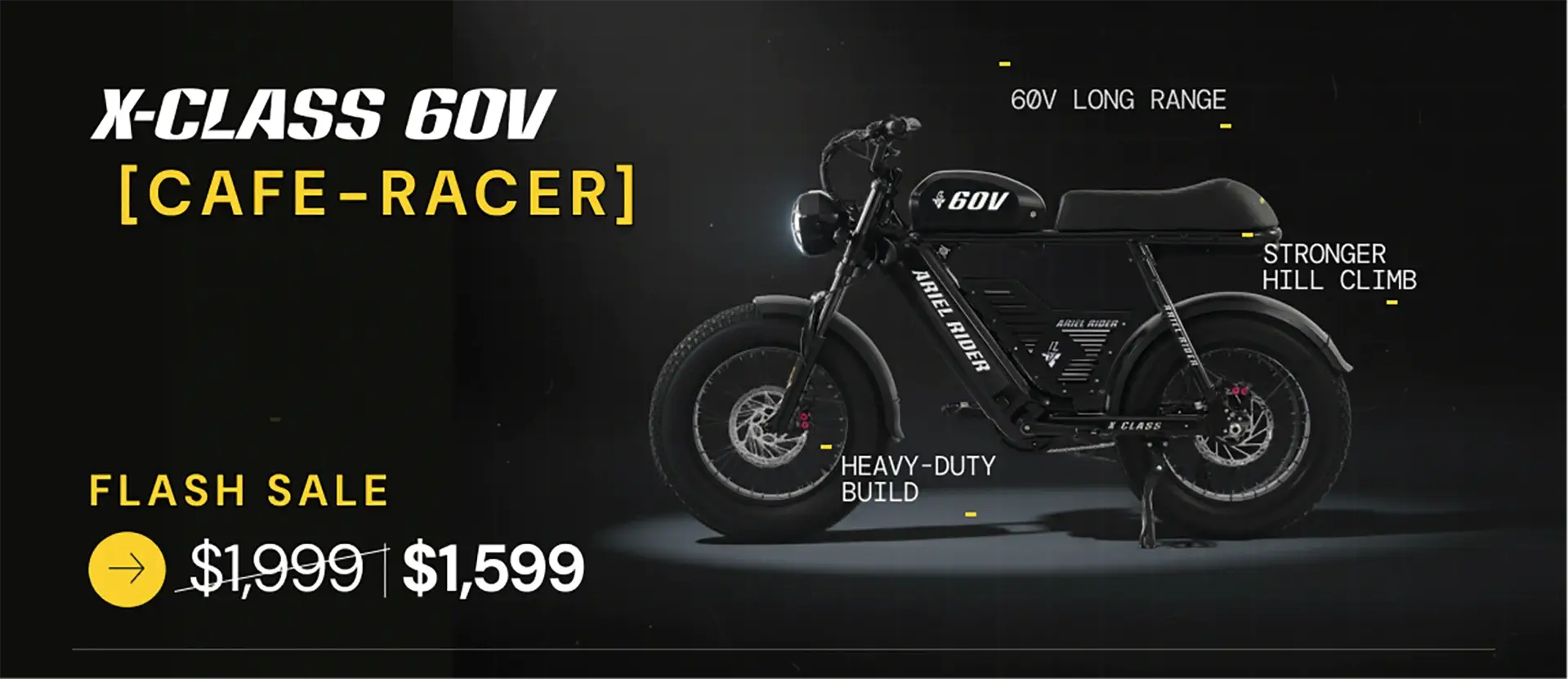Winter is here, and while bikes like Ariel Rider models are built for adventure, colder temperatures and wet conditions can pose challenges for both riders and bikes. Whether you're braving snowy trails or commuting on icy streets, taking the right steps to maintain your bike during winter is essential for its performance and longevity.
In this guide, we'll address common questions like "How do I protect my motorized bike in winter?" and "Can my bike's batteries survive the cold?" while offering practical, tips to keep your Ariel Rider bike in excellent condition all winter long.
1. How Does Cold Weather Affect Bike Batteries?
One of the most frequently asked questions about bike winter care is how cold weather impacts batteries. Bike batteries, particularly lithium-ion ones, are sensitive to temperature drops. When temperatures dip below freezing, the battery's range and performance can temporarily decrease.
- Protect Your Battery: Always remove the battery from your Ariel Rider bike when storing it outside. Keep it indoors in a dry, room-temperature environment.
- Charging Tips: Charge your battery at room temperature. Avoid plugging in a cold battery straight from a winter ride, as this can damage its cells.
- Optimize Your Rides: Expect reduced range in cold weather, so plan shorter trips or carry a spare battery for extended rides.
For Ariel Rider-specific tips, refer to your model’s user manual or visit our support page.

2. How to Keep Electrical Components Dry and Safe
Winter conditions like snow, slush, and road salt can affect your Ariel Rider bike’s electrical system. Proper protection and maintenance will ensure uninterrupted rides.
- Waterproofing: Ariel Rider bikes are designed to handle wet conditions, but adding extra protection to exposed connectors with dielectric grease can safeguard them from moisture and corrosion.
- Post-Ride Cleaning: After riding through snow or salt-covered roads, wipe down your bike with a damp cloth. Focus on cleaning around connectors, the display, and wiring to remove debris and prevent damage.

3. Should I Switch to Winter Tires for My Bike?
Traction is critical during winter rides, especially on snow or icy roads. Many Ariel Rider customers ask if winter or studded tires are necessary for their bikes.
- Studded Tires: If you live in an area with frequent ice, upgrading to studded tires can significantly improve safety. These tires provide better grip on slippery surfaces.
- Lower Tire Pressure: Slightly reducing tire pressure can improve traction by increasing the tire's contact surface with the ground. However, check your tire’s PSI recommendations to avoid over-deflation.
4. Protecting Your Bike Frame and Moving Parts
Winter grime and road salt can damage your Ariel Rider bike’s frame and components if left unchecked. Here's how to keep your ride looking and performing like new:
- Regular Cleaning: Use warm water and a mild bike cleaner to wash away salt, dirt, and debris. Avoid high-pressure washers that can force water into sensitive areas like bearings.
- Winter Lubrication: Apply a winter-grade lubricant to your bike’s chain, derailleur, and other moving parts. Winter lubes are thicker and provide longer-lasting protection against moisture and rust.
5. Where Should I Store My Ariel Rider Bike in Winter?
Proper storage is essential for keeping your bike safe during the colder months. A common question is whether you can leave your bike outside during winter. While Ariel Rider bikes are durable, extreme conditions can still take a toll.
- Indoor Storage: Ideally, store your bike in a dry, temperature-controlled space. This protects both the battery and frame from freezing conditions.
- Outdoor Storage: If indoor storage isn't an option, invest in a high-quality waterproof cover. Make sure the bike is clean and dry before covering it.

6. Can I Ride My Ariel Rider Bike in Snow?
Yes, many Ariel Rider models are well-suited for winter riding. However, there are precautions to take:
- Visibility: Winter days are shorter, so equip your bike with bright front and rear lights. Add reflective decals or wear reflective gear to stay visible in low-light conditions.
- Brake Performance: Check your brakes regularly. Wet or icy conditions can reduce braking efficiency, so ensure pads and rotors are in good condition.
7. Is Winter Maintenance Necessary for Bikes?
Regular winter maintenance will keep your Ariel Rider bike in top shape, extending its lifespan and ensuring safety.
- Inspect Your Bike Weekly: Check the brakes, tires, and drivetrain for wear or damage. Look for any signs of rust or corrosion on exposed metal parts.
- Professional Tune-Ups: Consider scheduling a mid-winter maintenance check with a trusted motorized bike technician. This is particularly helpful if you ride frequently in harsh conditions.
8. Extra Tips for Winter Riding Comfort
Riding your Ariel Rider bike in winter isn’t just about keeping the bike safe; your comfort matters too.
- Dress for the Weather: Wear insulated gloves, waterproof shoes, and layered clothing to stay warm and dry.
- Plan Your Routes: Stick to well-maintained roads and paths. Avoid areas prone to black ice or deep snow.
Why Winter Care Matters for Your Ariel Rider Bike
Winterizing your Ariel Rider bike isn’t just about maintaining its performance; it’s about protecting your investment. With proper care, your bike will be ready to deliver exceptional rides, no matter the season. If you’re looking for more tips, check out our Ariel Rider blog for in-depth guides and product updates.
Whether you're wondering "Can I leave my e-bike outside in winter?" or "What’s the best way to store a bike battery in cold weather?" we hope this guide answers your questions. For additional support, contact us via our Customer Care page. Safe riding!





